“So it’s you and a syringe against the Capitol? See, this is why no one lets you make the plans.” — Suzanne Collins, Catching Fire
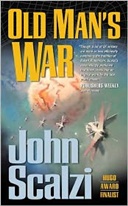 |
Old Man’s War, by John Scalzi This was a Hugo or Nebula sci-fi award winner in, I think, 2005. It’s what I would call nostalgia sci-fi, written in the Robert Heinlein style, with lots of leery sex and drunken-sounding conversations between characters as a device to move the narrative along. I think the resemblance to Heinlein is an intentional tribute, and I suspect that was one of the reasons Scalzi’s novel won the award. A lot of fans love old school sci-fi, and we read it when we can find it. Old Man’s War was sufficiently old-school to keep my interest, and even rekindled a spark of wonder at all the possibilities the universe may hold. It’s a good read for any sci-fi fan, and I mean it — the sequel, The Ghost Brigades, is waiting for me on my Nook. |
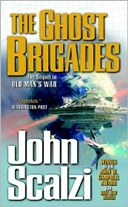 |
The Ghost Brigades, by John Scalzi The sequel to Old Man’s War, this one focused on the special forces soldiers of the Colonial Union, aka the Ghost Brigades. It flows seamlessly from the first book while digging deeper into the rebodied soldiers’ BrainPal technology and the political maneuvering of the CU, setting the stage for another sequel which will, I hope, look at colonial life. Since two prominent CU soldiers (one from the first book; one from the second) are about to be rebodied as colonists at the end of The Ghost Brigades, I think that is the likely direction Scalzi will take. Good sci-fi, fun reading. |
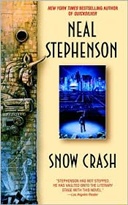 |
Snow Crash, by Neal Stephenson This early cyberpunk novel was published in 1992, 10 years after the movie Tron came out and just as the general public was beginning to get its hands on the tools needed to access the online world. Read in the context of later cyberpunk sci-fi (particularly the novels of William Gibson), Snow Crash is interesting as an artifact of the very early days of the internet. Even though 1992 was still early days, Stephenson’s Snow Crash seems horribly dated, stuck in Tron-derived notions of cyberspace (which he calls the “metaverse”) as a quasi-physical space, with data represented in geometric, building-like forms and hackers as stylized avatars zooming from one stack of data to the next on cybercycles and cybermonorail trains, surprisingly at sub-light speeds … why so slow? But never mind the dated cyber-talk … Snow Crash is still a ripping sci-fi adventure, with good characters you come to care about (one of whom is actually named “Hiro Protagonist”), and some stunning concepts (the breakup of the USA into corporate mini-states and multi-national “franchulates,” but especially the vast Raft, drifting in a clockwise circle around the Pacific Ocean, composed of thousands and thousands of ships lashed together, home to stateless millions). When a writer has a cool idea and can describe it in rich detail, it comes alive and you can not only see it, but believe it could happen. Neal Stephenson was particularly good at this in both Anathem and Snow Crash. As with the other Stephenson novel I’ve read, Anathem, there is at the center of this story an esoteric concept, one that Stephenson explains in page after page of stilted pedantic dialog between Hiro Protagonist and various foils. I found myself skimming those parts. The concept wasn’t that esoteric, and could have been explained in a couple of pages. Since I’ve read only two of Stephenson’s sci-fi novels, I shouldn’t say this is characteristic of his writing, but I’m beginning to suspect it is. Nevertheless, the story was great and I’ll read more Stephenson.
|
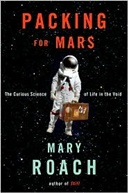 |
Packing for Mars: The Curious Science of Life in the Void, by Mary Roach Okay, this isn’t sci-fi, but it fits right in with the sci-fi theme of these reviews. A serious sci-fi fan would consider a book about actual space travel essential background reading. I love Mary Roach’s infectiously enthusiastic reportage on subjects I want to know more about, especially the piggy-dirty details (think sex, think dead bodies). This latest, an examination of the number one limiting factor in space travel — the human being and all the special accommodations that must be made for our animal needs — is a joy to read, with laugh-out-loud nuggets of detail interspersed with serious discussions of the difficulties we encounter in nearly every aspect of space travel, from food storage to waste disposal, from bone loss to the anger borne from being cooped up in close quarters with other people, to the many sheer physical dangers of space travel, any one of which would kill you in a New York minute, to the unending PR problems both US and Russian space agencies have with astronauts and cosmonauts speaking out of turn. Lots of solid information, lots of fresh space gossip, and throughout, Mary Roach’s unflinching directness on any topic, no matter how squalid (reading about “escapees” alone is worth the price of the book). Mary Roach conveys the near-impossibility of success in space, but also the excitement of knowing that we’ve overcome many of those barriers. The biggest barrier remaining is the long-term effect of weightlessness on the human body (in fact, weightlessness is a problem in nearly every aspect of space travel, as Mary Roach details). Mary convinced me that I would not want to go on a 500-day trip to Mars and back. Would Mary go? She probably would — and that’s what makes Packing for Mars such an exciting read.
|
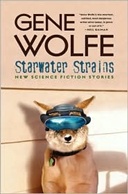 |
Starwater Strains, by Gene Wolfe I started reading Gene Wolfe in the 1970s, when he wrote science fiction with an overlay of fantasy: The Fifth Head of Cerberus, The Island of Doctor Death and Other Stories and Other Stories. I fell away from Wolfe when he began writing sword & sorcery fantasy: The Book of the New Sun series and others. I picked up a later book, Pirate Freedom, and was appalled at how poorly it was written. Recently, though, I picked up Starwater Strains, a collection of what the book jacket described as science fiction stories, hoping that at last Gene Wolfe had gone back to writing good sci-fi. And it is good sci-fi, at least the three or four longer stories contained in this collection. Gene Wolfe, far more than other sci-fi authors, not only expresses a sense of wonder, he evokes that sense of wonder — the bottom-falling-away feeling that anything is possible — in the reader, which is a rare gift. I hope he writes more in the sci-fi vein, and look forward to a collection of longer stories and possibly even a novel (without the sword & sorcery stuff).
|
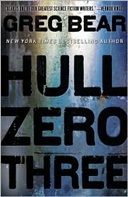 |
Hull Zero Three, by Greg Bear Good science fiction, although — and maybe it’s just me — somewhat confusing in its physical description of an interstellar ship packed with human colonists on ice. Though descriptions of the ship are central to the story, as a small band of reawakened colonists make their way around inside and outside it, I had a hard time visualizing what Greg Bear wanted me to see, and never really did grasp what the ship may have looked like. That to me is an important part of any “hard” science fiction story, and Bear’s inability to get it across took a little from my enjoyment of what was otherwise a fascinating story. |
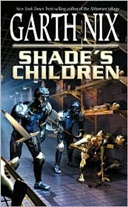 |
Shade’s Children, by Garth Nix A gripping story in the post-apocalyptic urban future strain. In the devastated city of this novel, all adults have disappeared and children are bred to be harvested and remanufactured into specialized fighting and hunting creatures to be used by human-like overlords in endless battles. The story centers on a few escaped children who work with a virtual machine intelligence named Shade to first learn about, then fight the overlords. The writing is first-rate, the descriptions of the abandoned and fought-over city are vivid, and the characters are memorable. This was an intensely-fun read; I’ll be keeping my eyes open for a sequel.
|
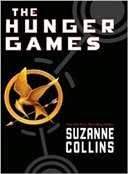 |
The Hunger Games, by Suzanne Collins This is the first installment of a trilogy (Hunger Games, Catching Fire, and Mockingjay). Suzanne Collins’ trilogy is classified as “young adult” fiction, but as with other YA titles I’ve read (most notably M. T. Anderson’s two-volume Octavian Nothing series, or Philip Pullman’s His Dark Materials trilogy), completely satisfying as adult fiction. Suzanne Collins starts off where Shirley Jackson ended with her famous short story, The Lottery. The first book follows two teenagers from District Twelve as they compete in, and win, the annual Hunger Games, and ends with their triumphant return to District Twelve, holding out the promise of further revelations in the next two books. I have to say, this is absolutely great stuff. Harry Potter with a bite, if you will, and what a bite. The games are about literal life and death: the winners, Katniss and Peeta, win not only by surviving, but by killing off their fellow competitors.
|
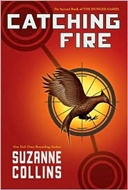 |
Catching Fire, by Suzanne Collins The exciting continuation of the story begun in The Hunger Games, this sequel describes Katniss’ awakening to the notion of an uprising against the Capitol, and her adoption by the rebels as the public symbol of the uprising, an inspiration to the oppressed people of the Districts. Of necessity, there is some repetition of ideas and themes from the first book, but Suzanne Collins works in more than enough excitement and tension to keep you glued to the pages. This is an absolutely engrossing story, and if you haven’t yet fallen in love with Katniss, you will have by the end of this volume.
|
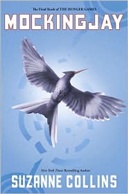 |
Mockingjay, by Suzanne Collins I ended Suzanne Collins’ trilogy with the beginnings of burnout. By the time I’d finished Mockingjay, I had grown weary of Katniss Everdeen’s childish, self-centered relationship with everything around her. I also anticipated that — as in the first and second books — she’d wind up competing in yet another Hunger Game, and that’s pretty much what happens. Still, I must say the series as a whole is exciting and hard to put down, and that Suzanne Collins manages to work a few surprises into this final volume. That said, the supporting cast of the uprising — not Katniss and her immediate circle of friends and associates — is made up of cardboard cutouts, and I kept thinking of those computer-generated battle scenes in the Lord of the Rings movies, where thousands of soldiers face off against thousands of Orcs, but you can’t really focus on any individual one. |